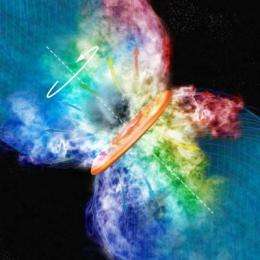Close-up movie shows hidden details in the birth of super-suns (w/ Video)

(PhysOrg.com) -- The constellation of Orion is a hotbed of massive star formation, most prominently in the Great Nebula that sits in Orion's sword. The glowing gas of the Nebula is powered by a group of young massive stars, but behind it is a cluster of younger stars and clumps of gas. Still gathering together under gravity's pull, these gas clumps will eventually ignite into stars.
The youthful cluster cannot be seen with traditional telescopes because of the surrounding gas and dust, but a new high-resolution time-lapse movie reveals the process of massive star formation with radio images a thousand times sharper and more detailed than any previously obtained. The movie shows that massive stars form like their smaller siblings, with disk accretion and magnetic fields playing crucial roles.
The way that massive stars form remains mysterious, in part, because massive stars are rare and tend to spend their youth enshrouded by dust and gas hiding them from view.
"We know how these stars die, but not how they are born," said Lincoln Greenhill, a principal investigator of the study and part of a team comprising scientists from the Harvard-Smithsonian Center for Astrophysics (CfA) and the National Radio Astronomy Observatory (NRAO).
Unlike Hubble and other visible-light telescopes, radio telescopes can penetrate dusty veils around stars. The research astronomers studied a massive young protostar called Source I (pronounced "eye") at radio wavelengths, using the National Science Foundation's Very Long Baseline Array (VLBA) as a powerful "zoom lens."
The VLBA yielded even sharper images than the famous Hubble photos of "proplyds," or protoplanetary disks in Orion. The team observed Source I at monthly intervals over two years and then assembled the individual images into a time-lapse movie.
The VLBA detected thousands of silicon monoxide gas clouds called masers - naturally occurring laser-like beacons often associated with star formation. Some masers were as close to the protostar as Jupiter is to our Sun, which is also a record. Many of the masers existed long enough for their motions to be tracked across the sky and along our line of sight, yielding their 3-d motions through space.
"Source I is the richest source of masers in the Galaxy, that we know of," said Lynn Matthews, lead author of the new work, who is now a researcher at the MIT Haystack Observatory. "Without the masers, we couldn't track the gas motions in such detail so close to this massive star, and would be relatively blind to its formation."
"In astronomy, it's rare to see changes over the course of a human lifetime. With this new movie, we can see changes over just a few months as gas clumps swarm around this young protostar," added Smithsonian astronomer and co-author Ciriaco Goddi.
The resulting movie reveals signs of a rotating accretion disk, where gas is swirling closer and closer to the protostar at the center. It also shows material flowing outward perpendicular to the disk in two large V's - actually the edges of cone-shaped streams of gas. Such outflows foster star formation by carrying angular momentum away from the system.
Intriguingly, the outflow streams appear to curve as they leave the disk. "The bending path of these masers provides key evidence that magnetic fields may be influencing gas motions very close to the protostar," pointed out Claire Chandler of NRAO, a co-principal investigator of the study.
Magnetic field lines are familiar from their effect on iron filings sprinkled around a bar magnet, outlining loops extending from one pole of the magnet to the other. In the case of Source I and other massive protostars, magnetic field lines may extend outward into space, wrapping in a helix that is shaped much like Twizzlers candy. Outflowing gas streams along those field lines.
"Magnetic fields are supposed to be weak and unimportant to the birth process for massive stars," said Matthews. "But masers would not travel along gentle arcs unless they experience some sort of force - probably a magnetic force."
The data don't show whether the magnetic field arises in the star or in the accretion disk. Future observations by the Expanded Very Large Array (E-VLA) and the Atacama Large Millimeter Array (ALMA) may be able to distinguish between competing hypotheses. The team plans to look for other fingerprints of magnetic fields around Source I.
"Our two-year movie is just the beginning," said Smithsonian astronomer and co-principal investigator Elizabeth Humphreys.
More information: The paper describing these findings will appear in the Astrophysical Journal early next year, in January 2010, and it is available online at arxiv.org/abs/0911.2473
Source: Harvard-Smithsonian Center for Astrophysics (news : web)



















